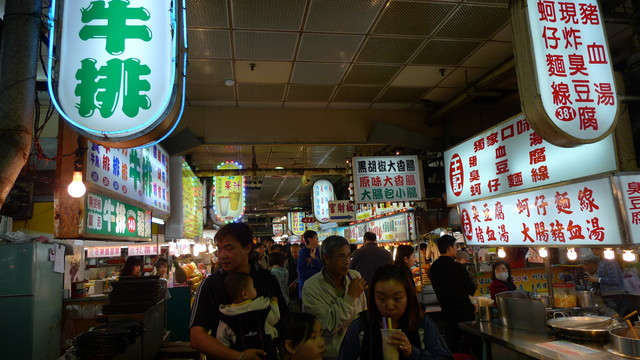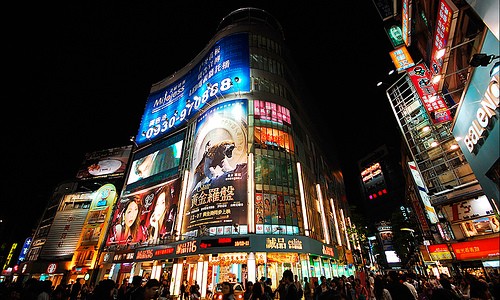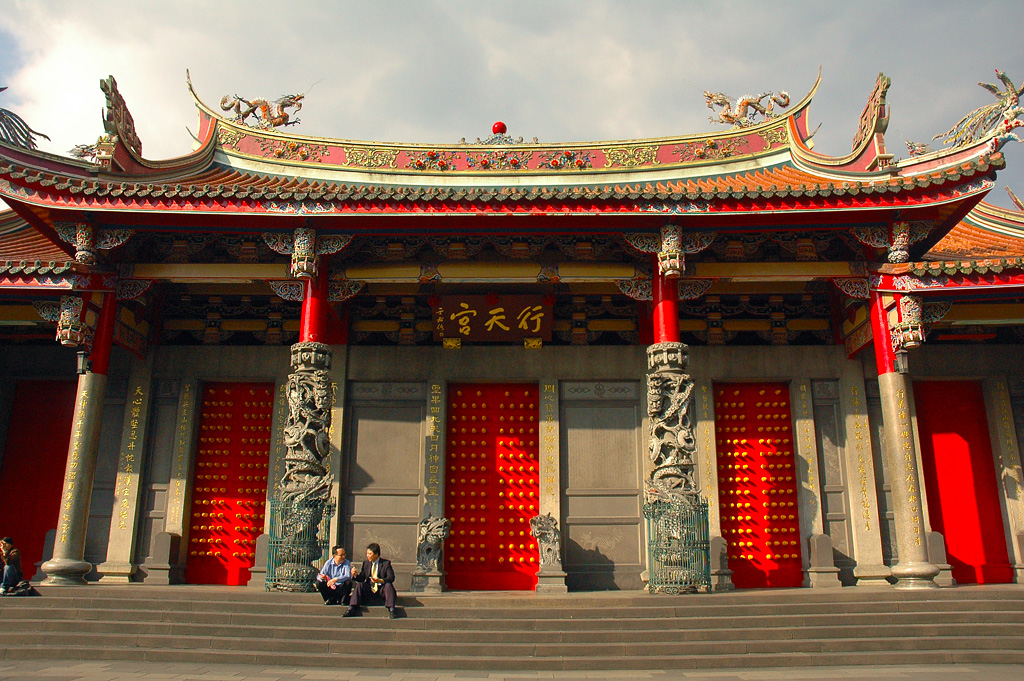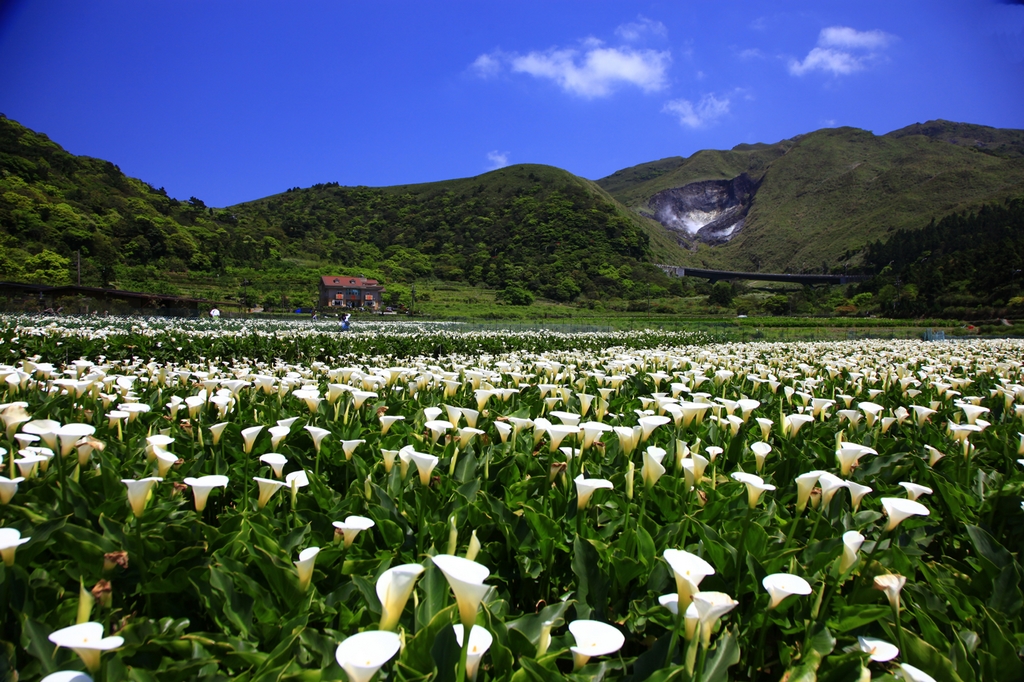
Shilin Night Market is the one of the largest night markets in Taipei. The market is centered on Yangming Theater and Cicheng Temple. The night market is formed by many prosperous shops on Wenlin Road, Dadong Road and Danan Road, etc. Among them, Shilin Market was built as early as in 1899 and the market is famous for various snacks and eatery. Many visitors have come to Shilin Night Market to enjoy the delicious foods, such as large pancake enfolding small pancake, hot pot on stone or Shilin sausage. Shilin Night Market has become a renowned place for great foods. Because the night market is close to many schools, students are the main customer group. Goods are sold at less expensive prices as compared to regular stores. There are special areas for furniture, clothing, photo shops or pet shops. The finery shops and cold dessert shops in "lovers lane" attract most student customers. Shilin Night Market covers a large area. When one walks in the turning lanes and alleys, he (she) would often find something unexpected. The night market is packed with many people during holidays. We can often see families carrying many things from shopping and enjoying good meals. Their satisfaction is fully shown from their happy expressions.
The National Palace Museum houses the worlds largest collection of priceless Chinese art treasures, one which spans Chinas nearly 5,000-year history. Most of the museums 620,000 art objects were part of the Chinese imperial collection, which began over 1,000 years ago in the early Song dynasty.
Dann Forest Park is an ecological park with a forest-like environment. Park roads are lined with trees such as camphor, cajuput, ficus and maples. Bushes and flower beds are planted throughout the park to help make the park into a lush, green space. The park is likened to the lungs of Taipei.

The name of Ximending came from the period of Japanese colonization. At that time most local residents live within Taipei City. Ximending is the center for recreation. In 1896, the first theater "Tokyo Stand" was set up. In 1922, the place was officially called Ximending. In early years, the main business activity in Ximending was going to cinema theater. At that time, most cinema theaters are on Emei Street, Chengdu Road and Xining S. Road. They were the center of Ximendings development. After the central government of R.O.C. was reinstated in Taiwan in 1949, a large sum of capital was poured into Ximending. Other than cinema theaters, there were department stores and other entertainment attractions. After the completion of Zhonghua Business Buildings, Ximending became the largest business and entertainment center in the country. In 1990s, the business and entertainment activities of Taipei gradually shifted to East District. Later, Zhonghua Business Buildings were torn down for road construction. Ximending became silent for a while. Then, MRT Bannan Line was completed. Zhonghua Road was converted to be a prosperous main street under the planning of Taipei City Government. Furthermore, there are many emerging squares and activity locations. On holidays and at weekends, people gather here for art, culture events or sports, music performance. The business opportunities and people are coming back to Ximending.
Xinyi is a one-of-a-kind tourism area in Taiwan. A product of urban planning, it is the center of fashion and a place where Taipeis future is being created. The district has convenient transportation links to other parts of the city and region. The stores here sell the worlds best brands. Xinyi is also home to Taiwan biggest bookstore chain, Eslite and the international landmark Taipei 101 building. Four Four South Village (a restored military dependents housing complex), Songshan Cultural and Creative Park, an internationally-renowned Michelin star restaurant, eye-catching buildings and installation art, and the annual Taipei New Year Eve Party all further add to the sparkle of Xinyi District. For shopping, entertainment and delicious cuisine to art, culture and international MICE facilities, Xinyi District serves up the best of Taiwan.
The Taipei Zoo is the largest city zoo in Asia. Upon entering the grounds, you will find an extremely popular panda facility on your left. If you cant find the cute pandas, dont worry; theyre probably sunning themselves! Next, take the visitors tram. Listen to the recorded guide as he takes you along to the bird sanctuary, the Amphibians and Reptile House, the Penguin House and other areas such as the Tropical, African, Australian, Desert Animal Areas. In the Insect House, it is possible to come in contact with insects up close.On holidays, explanations are given at each site. Free-guided tours are also available upon advanced reservation. And if you love animals, you can consider adopting an animal and becoming its babysitter!

This very busy temple is devoted to Guan, a famous deified general who lived (A. D. 162-219) during the Three Kingdoms period. A man, who valued loyalty and righteousness above all things, Guangong is worshipped as the God of War; since he was adept at managing finances, he is also worshipped as the patron saint of businessmen. This is young temple, built in 1967, with a simple and dignified appearance. In front of the hall is a censer with a somewhat unusual design, its two handles in the shape of flying dragons and its four sides adorned with dragons’ heads stretching toward the sky. The courtyard of the temple is usually busy, with crowds of worshippers bowing their heads or kneeling in devotion. On the main altar you will see offerings of only fresh flowers and tea, since the temple forbids the killing of offering of animals. The temple also discourages the burning of ritual paper money as an offering to the deities and the spirits of the deceased, the staging of operas for the gods, the presenting of gold medallions in gratitude to the deities, and the like. The temple supplies free candles, and there is no donation box-a first for traditional religion in Taiwan! Many believers feel that this is a very efficacious temple, and it is frequently thronged with people praying for help and seeking divine guidance by consulting oracle blocks. Even the pedestrian underpass outside the temple is filled with fortune-tellers and vendors who take commercial advantage of the temples popularity.

One of the seven national parks in Taiwan, the Yangmingshan National Park is located between Taipei City and Taipei County, Taiwan. Under Japanese rule, it was designated part of the Daiton National Park in 1937. Yangmingshan is the home of famous writer Lin Yutang, the summer residence of Chiang Kai-shek, residences of foreign diplomats, the Chinese Culture University, the meeting place of the now defunct National Assembly of the Republic of China, and the Kuomintang Party Archives. Yangmingshan is also the rumored location of an electronic intelligence listening post maintained by the Republic of China government in cooperation with the United States to monitor communications within the Peoples Republic of China. The Wuchih Mountain Military Cemetery borders the Hsichih end of the National Park. The National Park is famous for its cherry blossoms, hot springs, sulfur deposits, venomous snakes and hiking trails, including Taiwans tallest and one over the extinct volcano Seven Star Mountain. The Park is currently served by bus lines. The proposed Beitou Cable Car would link it directly to Xinbeitou Station.
Located on Jhongshan North Road, the Shihlin Official Residence was the former home of the late President Chiang Kai-shek. In 1996, it was placed under the care of the city government and partially opened to the public, lifting the veil of mystery that had hung over the estate for nearly half a century. The expansive and elegant garden has a romantic European feel, with rose beds and tree-lined paths, making it a popular place for taking wedding photographs. A long flight of steps offers a panoramic view of Chihsing Mountain and is a favorite spot for couples.
A walk through the Dihua Street Area gives visitors a feel of Taipei Citys past. The old-town market has scores of shops selling a variety of traditional goods such as Chinese medicines and herbs, temple icons and incense, spices and dried food, colorful bolts of cloth, and bamboo and wooden crafts.